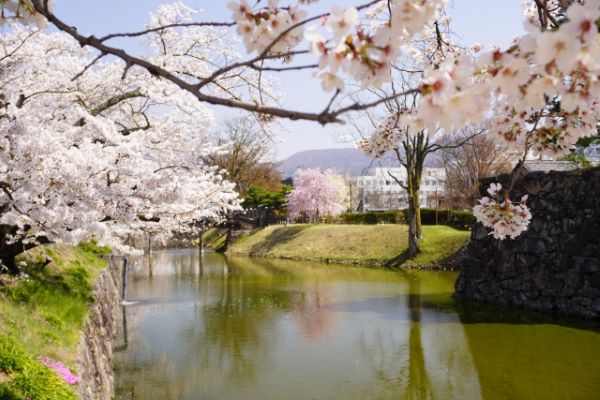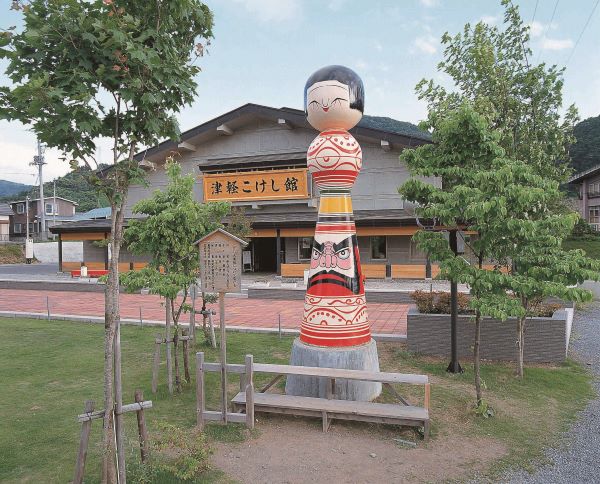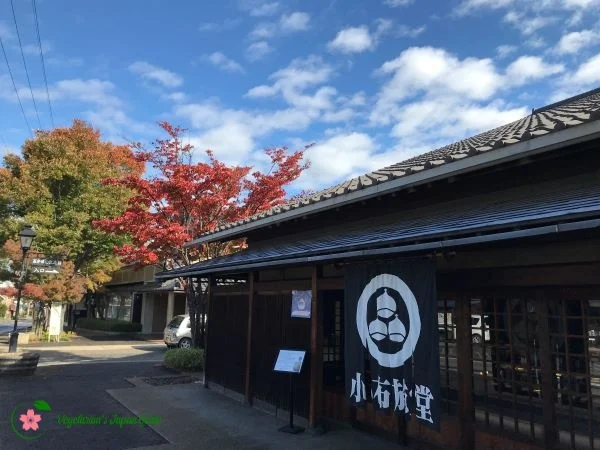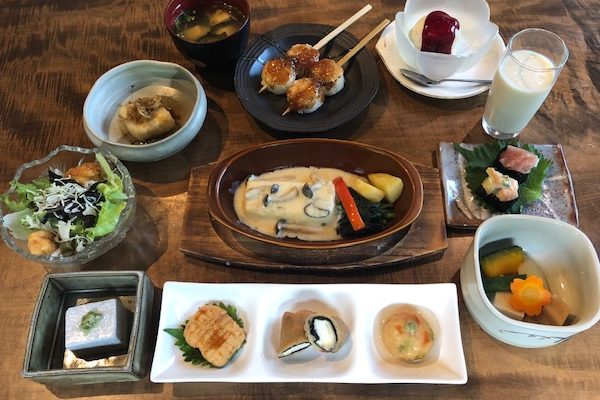Apart from Kamikōchi, Norikura Kōgen (乗鞍高原) is another breathtaking place in Matsumoto City in Nagano Prefecture. The best thing about the relatively off-the-beaten-path destination is that it isn’t as crowded as Kamikōchi, and you can drive there without relying on public transport. So read on, and find out more about the charm of Norikura Kōgen!
The gorgeous highland is a summer resort with abundant natural beauty where visitors enjoy mountain climbing and cycling from late spring to autumn. In winter, it becomes the perfect place for skiing and snowboarding. And after a day of physical activities, many choose to indulge in the natural hot spring to rejuvenate.
Below is a list of attractions you can trek to at Norikura Kōgen. They are listed in order based on their distance from Norikura Visitor Center (except Bandokoro Ōtaki Falls and Blue Resort NORIKURA).
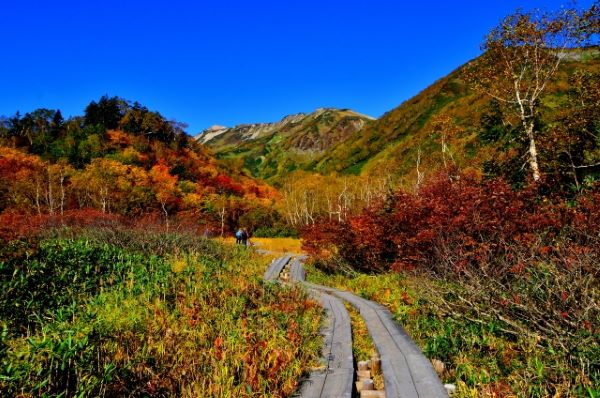
- Norikura Visitor Center (乗鞍観光センター)
- Norikura Echo Line (乗鞍エコーライン)
- Norikura Kōgen Onsen – Yukemurikan (乗鞍高原温泉 湯けむり館)
- Ushidome Pond (牛留池)
- Zengorō no Taki Falls (善五郎の滝)
- Norikura Kōgen Ichinose Danchi Meadow (乗鞍高原一の瀬園地)
- Sanbondaki Falls (三本滝)
- Norikura Tatamidaira (乗鞍畳平)
- Hiking to the Summit of Mt. Norioka
- Bandokoro Ōtaki Falls (番所大滝)
- Blue Resort NORIKURA (ブルーリゾート乗鞍)
HERE is a full map of Norikura Kōgen and Mt. Norikura, with major attractions labeled in English and Japanese. If you read Japanese, the trekking route maps HERE will give you a better visual idea of the routes that we describe below.
The Difference between Mt. Norikura and Norikura Kōgen
Mt. Norikura (乗鞍岳) refers to the 23 peaks in the south-east of the Hida Mountains (飛騨山脈). Among them, Kengamine (剣ヶ峰) is the highest, at an altitude of 3,026 meters. When it erupted a long time ago, Norikura Kōgen (or Norikura Highland in English) was created by the lava flown to the mountain’s east. The west end of the highland is higher, at an altitude of around 1,800 meters. At its lowest point, the altitude at the east end is approximately 1,100 meters.

As the summit of Mt. Norikura and Norikura Kōgen can be easily confused when you set your car’s navigation system or purchase a bus ticket, choose your destination carefully so you don’t end up somewhere you didn’t mean to arrive.
How to Get to Norikura Kōgen by Public Transport
If you don’t have access to a car, take a train to JR Matsumoto Station. From there, change for Matsumoto Dentetsu to get to Shin-shimashima Station (新島々駅). Then, change for Alpico’s Norikura Kōgen Route, which will get you to Norikura Kōgen in around 50 minutes.
For more information about how to get to Matsumoto, please refer to the access information in our Matsumoto article.
Please refer to the timetable HERE to plan your trip to Norikura Kōgen.
Heading to or Coming from Kamikōchi
If you plan to visit both Kamikōchi and Norikura Kōgen during the same trip, HERE is the timetable for the bus service that connects the two most beautiful destinations in Matsumoto.
Important Things to Keep in Mind at Norikura Kōgen
- There might be snow on the promenade from late May to early June, making the surface slippery.
- The bus services in Norikura Kōgen and Mt. Norikura only operate from July to October.
- Refer to HERE for the timetable.
- If you can, purchase a bear bell from the shop to keep the chances of a bear encounter to a minimum.
- If you see a bell placed at the side of the promenade, it is recommended that you ring it 2 – 3 times to inform the bears that humans are around.
What to Bring and What to Wear for Trekking at Norikura Kōgen
- Waterproof hiking shoes are best, especially when heading to the waterfalls.
- Depending on where in the Highland you are visiting, you might want to bring a pair of trekking poles.
- Remember to bring some high-energy snacks and enough water.
- Wear warm clothes if you are heading up in early spring or autumn.
- Enough cash. There are no ATMs, and many facilities only accept cash payments.
Joining a Guided Tour to Hike Mt. Norikura
If you are a beginner at hiking, it can be frightening to hike a peak over 3,000 meters tall in a foreign country. So, if you would like to be guided to the summit of Mt. Norikura or around Norikura Kōgen, Little Peaks’ experienced guides can help!
On their website, HERE, there are various options that you can choose from to fit your schedule. Simply translate the website to English using Google Chrome’s translation function at the right of the address bar.

The easiest way to make a reservation with them is by filling in the online form HERE. Typing in English is fine. They will get back to you once they review your schedule.
Important: Please note that the backcountry skiing tour is unavailable in English.
Fall Foliage Season at Norikura Kōgen and Mt. Norikura

The autumn foliage season at Norikura is from late September to October.
- The color of the foliage around the summit usually peaks from late September to early October.
- The foliage’s color from Ichinose Danchi to Sanbondaki Falls usually peaks from mid to late October.
- Around Bandokoro Ōtaki Falls, the fall color can last until early November.
Norikura Visitor Center (乗鞍観光センター)
Norikura Visitor Center (Chūbu Sangaku National Park Norikura Visitor Center) at the hillside of Norikura Highland is a facility you will want to visit first when you arrive at Norikura Kōgen.
Here, you can obtain the most up-to-date information on all attractions at the highland and Mt. Norikura. The staff will advise what to look out for during your stay based on the weather and road conditions. This information is critical to ensure your safety at Norikura Kōgen.
From July to October, Norikura Visitor Center is the terminal stop for bus services to Norikura Tatamidaira (乗鞍畳平), the base for hiking Mt. Norikura.
The visitor center is also where you catch buses departing for Kamikōchi (上高地) and/or Shirahone Onsen (白骨温泉).
Tip: You can rent an electric-assisted bicycle from Norikura Visitor Center for 8,000 yen per day between 10 am to 3:30 pm.
Information About Norikura Visitor Center
- The tourist information center is open from 10 am to 4 pm from April to November.
- Refer to HERE and scroll down for the visitor center’s calendar. It only opens on the days that are marked in yellow.
- The restaurant Okamisan Shokudō (おかみさん食堂) is open from 9 am to 5 pm.
- The last order for the light meal is at 2 pm.
Norikura Echo Line (乗鞍エコーライン)
The 20 km Norikura Echo Line is the road that connects Norikura Kōgen and Norikura Tatamidaira. If you want to drive along the highest elevation road in Japan, Norikura Echo Line is the one.
Although all in Japanese, HERE is a visual map of the route.
You can either drive or rent a mountain bicycle or an electric-assisted bicycle from the following facilities in Norikura Kōgen.
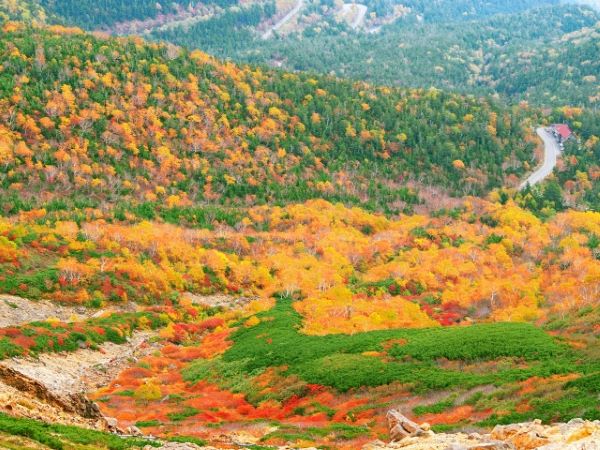
- North Star Outdoor Adventure (ノーススター アウトドア アドベンチャー)
- A mountain bicycle tour in English is available. For more information, please refer to their website HERE.
- Norikura BASE (乗鞍BASE)
- Norikura Visitor Center (乗鞍観光センター)
- The cost to rent an electric-assisted bike is
- 8,000 yen per day
- 535 yen for insurance
- Free helmet rental
- The cost to rent an electric-assisted bike is
- Norikura Nature Conservation Center (乗鞍自然保護センター)
- It is closed on Wednesdays except during the Golden Week and from mid-July to mid-August

Without a break and at a speed of 10 km/hour, it will take around 90 minutes to get to Norikura Tatamidaira and around 40 minutes to return to Norikuga Kōgen.
Tip: From July to October, shuttle buses run between Norikura Visitor Center and Norikura Tatamidaira.
Important: If you plan to drive, you will have to park your car at Sanbontaki Falls because private vehicles are prohibited from going further. From Sanbondaki Falls, you can take a shuttle bus, sightseeing bus, or taxi to get to Tatamidaira.
If you enjoy hiking, you can trek along a mountain trail from Sanbondaki Falls. But keep in mind the trail may be closed due to heavy rain. A one-way trip will take around 3.5 to 4 hours (a rough guide).
Norikura Snow Wall (Norikura-dake Haruyama Bus, 乗鞍岳春山バス)
The reason why the Norikura Echo Line isn’t accessible until July is that it is covered by a layer of snow that can be up to 10 meters deep. From April, snow removal work will gradually take place.
At the end of April, a 10-meter high snow corridor is formed on Norikura Echo Line. From the end of April to June, a special bus service called Mt. Norikura Haruyama Bus (Norikuradake Haruyama Bus, 乗鞍岳春山バス) operates so you can be awed by the magnificence of nature.
HERE is the service’s timetable. Please be aware that the bus will only stop at the last stop on the timetable from late May.
You can either purchase a ticket from the bus driver or Alpico’s ticket counter at Norikura Visitor Center. The cost of a ticket for the Mt. Norikura Haruyama Bus is below.
- 3,400 yen for adults
- 1,700 yen for children
Norikura Sunrise Viewing Bus (Norikura Goraikō Bus, 乗鞍ご来光バス)
For those staying overnight in Norikura Kōgen, you can also get up early to see the sunrise from Mt. Norikura.
HERE is the timetable for the bus service. Please be aware that the service requires reservation.
Norikura Kōgen Onsen – Yukemurikan (乗鞍高原温泉 湯けむり館)

After a day of intense physical activities in Norikura Kōgen, how about relaxing in the undiluted natural hot spring at the end of the day?
The spring source is from the Ōhi Silver Mine (大樋銀山), opened by the famous warrior Takeda Shingen (武田信玄). The milk-colored water at the hot spring is sulfur-based. Although you might find it stinky, it is perfect for fatigue recovery and muscle pain.
While you cannot rent a private onsen pool, you can adore the magnificent peaks of Mt. Norikura from the open-air communal pool.
You can also enjoy a plate of pasta or pizza at the facility’s restaurant. While many dishes served at the restaurant aren’t vegetarian, you check with the staff to see if meat and seafood can be excluded from the dish using the phrases in our Essential Japanese Travel Phrases for Vegetarians and Vegans article.
Tips:
☛ Check with the staff to see if the bargain deal, hot spring + meal set ticket is still on sale.
☛ The range of free toiletries is limited. It would be a good idea to bring your own.
☛ Utilize the free lockers to store your valuables in the changing rooms.
Norikura Kōgen Onsen – Yukemurikan’s Opening Hours, Cost, and Access Information
- Yukemurikan is open from 10 am to 8:30 pm.
- The last admission is at 8 pm.
- The restaurant is open from 11 am to 7 pm (last order).
- Please refer to their business calendar at the bottom of the official webpage HERE. Yukemurikan won’t open on the days that are blacked out.
- The cost of enjoying the hot spring is
- 730 yen for junior high school students and older
- 310 yen for children over 3 years
- 630 yen to hire a bath towel
- 210 yen to hire a hand towel
- If you plan to take a bus, please get off at Norikura Kōgen Tourist Information Center (乗鞍高原観光センター).
Zengorō no Taki Falls (善五郎の滝)

Located at an altitude of 1,525 meters is one of the Three Great Waterfalls of Norikura, Zengorō no Taki Fall. It is the closest scenic attraction to Norikura Tourist Center.
Zengorō no Taki Fall has a height of 21.5 meters and a width of 8 meters. The magnificent waterfall is somewhat unique in the way that it falls like a large curtain (most waterfalls in Japan don’t fall uniformly, Sanbondaki Falls on the Echo Line is a good example).
Zengorō no Taki Fall is an important training ground for the Shugendō practitioners when they train at Norikura. For more information about Shugendō, please refer to our article on Mt. Yoshino.
From the observatory, you can head down the stairs to view the waterfall up close.
Zengorō no Taki Fall is one of the most popular attractions in Norikura Kōgen throughout the year. When it becomes an icefall in winter, many hikers put on their snowshoes to adore the natural wonder.
It is said that Zengorō no Taki was formed by continuous erosion by the Koōno River (小大野川) on the lava rock formed by the eruption around 43,000 years ago. The erosion of the lava rock is still occurring today, with the waterfall receding slowly. If you check out the edge of the river downstream, you should be able to see traces of the old waterfall basin.
Tips:
☛ Plan your visit to Zengorō no Taki Fall in the morning for a chance to see a rainbow crossing the waterfall.
☛ Zengorō no Taki Falls goes hand in hand with Ushidome Pond (refer to below). This is particularly the case if you have trekked down to the waterfall basin. From Zengorō no Taki Falls, it is a 30-minute trek through rich nature to the trailhead of the Ushidome Pond promenade.
Why the Waterfall was named Zengorō
If you wonder why the waterfall has a human’s name, it is said the waterfall was named after a fisherman called Zengorō after he nearly fell into the waterfall basin while catching a large chor fish.
Another theory is that the chor fish, which was so strong that it almost dragged Zengorō into the waterfall basin, is actually the waterfall’s god. As a sacred training ground for Shugendō, the god didn’t want Zengorō to fish/kill living creatures at Zengorō no Taki. So he used his power to scare Zengorō away.
Information about the Accessibility of Zengorō no Taki Falls
- The closest bus stop is Suzuran (鈴蘭) or Suzuran-bashi (すずらん橋).
- From Suzuran-bashi, it will only take 5 to 10 minutes to walk to the observatory.
- If you are coming from Ichinose Danchi or park your car at the car park at the Tourist Center side, it will take around 10 to 15 minutes to get to the observatory.
- From the closest car park or bus stop to the waterfall’s observatory, it is around a 15-minute walk on a flat dirt road (sneakers are recommended).
Important: The surface will be slippery around the waterfall basin.
Ushidome Pond (牛留池)

After seeing the spectacular Zengorō no Taki Falls, how about trekking further to Ushidome Pond to admire its beauty?
From Zengorō no Taki Falls, it will be a 30-minute trek to the starting point of the 15-minute Ushidome Pond loop course. After you adore the gorgeous lake, you can choose to either trek back to Suzuran-bashi (すずらん橋) on the road or board the bus from the bus stop, Kyūkamura (休暇村).
Ushidome Pond is the pond that represents Norikura Kōgen. Conifers surround the pond, which is situated at an elevation of 1,590 meters. When the lighting is right, you can get a stunning photo of Mt. Norikura reflected on the pond’s surface.
In summer, many wild birds gather at the pond. Walking on the well-maintained promenade, you can also observe various alpine plants.
In May, it is the skunk cabbage season. And in June, you will find Menyanthes’ small gorgeous flowers growing out of shallow water.
The most interesting thing along the promenade is probably a tree named Nejineji (ねじねじの木). We bet you can’t find another tree growing this way!

Tip: The best time to visit Ushidome Pond is early morning or late afternoon. During the day, Mt. Norikura is covered by clouds most of the time.
Why Was the Pond Named Ushidome?
Ushidome literally means “cow stops” in Japanese. In the good old days, when cows were grazing in Ichinose, the pond was where cows gathered.
How to get to Ushidome Pond
- The closest bus stop is Bandokoro Ōtaki (番所大滝バス停).
- From Ichinose Danchi, take the promenade called Kuchibune no Kei (口笛の径). Trek down a gentle slope for 30 minutes, and you will arrive at Ushidome Pond (elevation difference is around 100 meters).
- The promenade from Kyūkamura (休暇村) is wheelchair accessible.
- A round trip from Kyūkamura will take around 15 minutes.
Important: The wooden trail will be slippery when wet on a rainy day or early spring with leftover snow from winter.
Norikura Kōgen Ichinose Danchi Meadow (乗鞍高原一の瀬園地)
After you had your fill of the view at Ushidome Pond, the next attraction you can trek or cycle to is Ichinose Danchi.
The promenade from Ushidome Pond will eventually lead you to Azami Pond in the meadow after a 40-minute trek.
Norikura Kōgen Ichinose Danchi is a beautiful park in the middle of the highland at 1,500 meters. The park has a spacious grassland with ponds and mountain streams and is perfect for a relaxing stroll or a picnic.
As the road is relatively flat, how about renting a bicycle and cycling around the park with a light breeze blowing on your face?
If you plan to follow the looped promenade and check out most parts of the meadow, it will probably take around 2 to 2.5 hours.

Tip: The flower season at Ichinose Danchi is from late April to July.
Azami Pond (あざみ池)
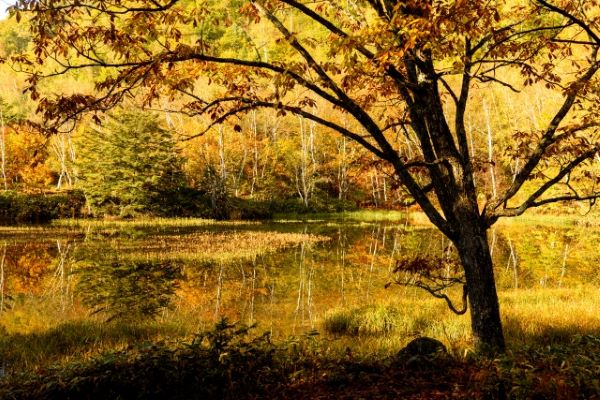
The first pond that you will encounter is the Azami Pond. It is where many wild birds gather in Ichinose Danchi. When they are in the mood to communicate with each other, it can be quite a nice symphony!
The pond was named Azami because its shape looks like a thistle leaf. From May to June, white bogbean flowers will be blossoming.
In late June, if you look carefully, you might find Moria frog eggs around the pond!
Maime no Ike Pond (まいめの池)

The most picturesque part of Ichinose Danchi is probably Maime no Ike. It is one of the best photography spots in Norikura Kōgen, day and night.
The fall foliage season at Maime no Ike starts in early October and peaks from mid to late October.
Trekking on the promenade, you will first go past a small marsh called Shinobu no Ike (偲ぶの池). In autumn, the color of the grass growing out of the marsh will turn brown, echoing the redness of the foliage on the trees close by.
Apart from the reflection of Mt. Norikura on Maime no Ike, many photographers also like to focus their lenses on the trees and their reflections in the pond.
One of the best times for photography is in the early morning, when you will likely get some morning mist above the pond, making your photo more mysterious. If the weather conditions are right, you will get a photo of the fall leaves shining with the morning sun as a backlight.
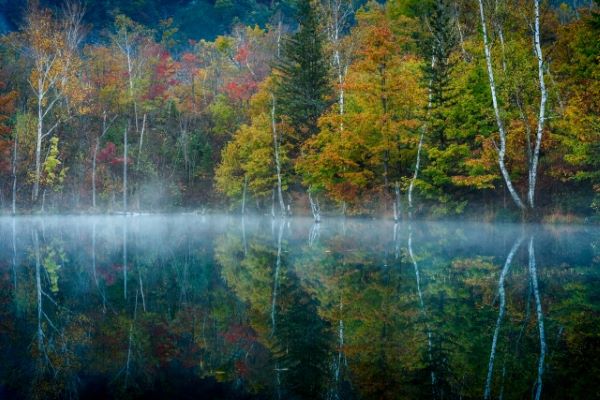
If you can access a car, visit Maime no Ike again at sunset for the sunset reflection followed by a sky of stars, also reflected in the pond!
From the closest car park, it is only a 5-minute walk. So there should be no need to worry about getting lost.

Dojō Pond (どじょう池)
Trekking further into Ichinose Danchi from Maime no Ike Pond, Dojō Pond is another scenic place in the meadow.
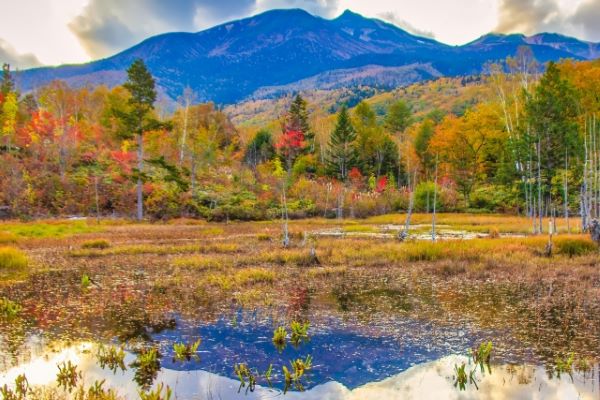
This gorgeous pond in the photo has a name that isn’t compatible with its beauty. Dojō in Japanese means kuhli loach. It was named after the fish because there is a large population of kuhli loach in the pond.
While you might not be able to see any kuhli loach from the surface, you can definitely see skunk cabbage floating. If you visit Norikura Kōgen in May, you will get to admire the white flowers of the skunk cabbage.
Tip: As the sun goes down the horizon at Mt. Norikura, the best time for photographs at Dojō Pond is in the afternoon or even closer to sunset
The closest bus stop is Kankō Center-mae (観光センター前), which is 2 km away.
How to Get to Norikura Kōgen Ichinose Danchi
- From Kyūkamura (休暇村) bus stop, it is around a 10-minute drive or around a 30-minute walk.
- You can also make a detour to Zengorō Falls (善五郎の滝).
Important: Before you wander off, please use the toilet close to the Ichinose Parking Lot, as you won’t find another one in the park.
Sanbondaki Falls (三本滝)
Sanbondaki Falls was chosen as one of the Top 100 Waterfalls in Japan in 1990. It is also one of the Three Great Waterfalls in Norikura (乗鞍三滝).
Technically, and just like its name, Sanbondaki Falls is formed by three individual waterfalls with different water sources. Because of the unique terrain structure, the water from different high grounds falls into the same area.
From the observatory, we can admire the magnificence of three waterfalls between 50 and 60 meters high.

Standing in front of the waterfalls, you will have Mumeisawa no Taki Falls (無名沢の滝). Of the three waterfalls, it has the smallest volume of water falling from the cliff, but it is the tallest.
In the middle, there is Honzawa no Taki Falls (本沢の滝), the most spectacular waterfall of Sanbondaki Falls. Just like Zengorō no Taki Falls, in ancient times, practitioners of mountain worship used to train underneath/around the waterfall.
Lastly, the Kuroizawa no Taki Falls (クロイ沢の滝) at the right is a three-tier waterfall with water flowing over the dark-colored rock cliff.
HERE is a map of the 2 km trekking trail to Sanbondaki Falls. As it is in Japanese only, you can also get more information about the course and the condition of the promenade from Norikura Kōgen Tourist Center (のりくら高原観光案内所).
As a side note, the waterfall basin is at 1,840 meters.
Information about the Accessibility of Sanbondaki Falls
- The closest bus stop is Sanbondaki (三本滝バス停).
- A return trip from the bus stop will take around 75 minutes.
- The tourist season is from June to early November.
- In winter, Sanbondaki Falls will become an icefall. It will be very dangerous to trek in the area. With heavy snowfall, directory signs are most likely covered by snow. Thus, one can easily get lost.
Important: After passing the suspension bridge, please walk carefully, as the large rock you will be walking on can be slippery
Norikura Tatamidaira (乗鞍畳平)
The promenade takes just around 30 minutes to get to, which is great for mountain hiking beginners and those who are less fit to still be able to enjoy the blessing of nature.
For those who want to hike to the highest peak, Kengamine, a one-way trip will take around 90 minutes. Along the mountain trail, on top of the alpine plants, spectacular views of surrounding mountain ranges, such as Mt. Hotaka (穂高連峰), will unfold before you!
Tatamidaira is an area surrounded by a sea of flowers. From early July to early August, if you walk along the promenade, around 50 different alpine plants should bloom!
The flower field, located at an altitude of 2,700 meters, can be explored through the wooden looped promenade. The course will only take you 30 minutes.
Late September to early October is the fall foliage season at Mt. Norikura. So how about escaping the heat in the city center and chilling down at Norikura and being amazed by the bright autumn leaves scenery?
Hiking to the Summit of Mt. Norioka

A return trip from Tadamidaira to the highest peak, Kengamine, will take just about 3 hours.
Please be aware the weather up in the mountain can change rapidly. Wearing appropriate hiking gear will ensure a safer and more pleasant trip.
Important: Please note there are no toilet facilities at the summit.
Tip: In summer, you can enjoy summer skiing from July to mid-August around the bus stop Kata no Koya-guchi (肩の小屋口). You can also start your hike from this bus stop.
Bandokoro Ōtaki Falls (番所大滝)
Bandokoro Ōdati Falls, the last Three Great Waterfalls of Norikura, is probably the most spectacular and powerful waterfall in Norikura Kōgen.
Located at the west end of Norikura Kōgen, the waterfall, at an altitude of 1,248 meters, has a width of 15 meters and a height of 40 meters. With the amount of water pouring down from the cliff, you will surely feel the power of nature when you adore it from the observatory.
In summer, just by watching the waterfall, it feels like the temperature around you drops by a few degrees. In autumn, the nature surrounding Bandokoro Ōtaki Falls will be dyed with vivid color, making it one of the best fall foliage hunting spots in Norikura Kōgen.
From the bus stop/car park to the observatory, it is only a 5-minute walk on a well-maintained promenade. But the stairs down to the waterfall are quite steep and narrow. So, please walk carefully, especially when you descend.

Trekking upstream on the Sengenbuchi Promenade (千間淵遊歩道), there is another waterfall that you will encounter. This time, it is a small gorgeous waterfall called the Bandokoro Kotaki (番所小滝). At the end of the promenade, the mysterious emerald green Sengen Swamp awaits.
Tip: The best season to visit Bandokoro Ōtaki is late May for the fresh spring color and mid to late October for the fall foliage.
Information about the Accessibility of Bandokoro Ōtaki Falls
- The closest bus stop is Bandokoro Ōtaki (番所大滝バス停).
- A round trip from the bus stop will take around 60 minutes.
- You can also choose to board from Kumiai-mae (組合前). It is the closest bus stop from Sengen Swamp.
- The tourist season is from the end of April to mid-November.
- If you plan to drive, there is a charge to park in the car park. Please put the money in the box at the side of the entrance
- 200 yen for a standard car
- 500 yen for larger vehicles
Important: The observatory’s surface will be slippery.
Blue Resort NORIKURA (ブルーリゾート乗鞍)
Blue Resort NORIKURA is also known as Mt. Norikura Snow Resort.
A hidden gem in Nagano, from mid-December to March, you get to ski on various types of terrain. Whether you are a beginner or advanced, you will enjoy a day of skiing here at Norikura Kōgen!

The snow produced by the favorable weather conditions is so fine that it slips through your fingers when you pick it up. The powder can sometimes last until the afternoon!
If you come with young kids, they can enjoy going down the slope on a sled in the designated kids’ park.
For more information on the cost, the courses, and ski gear rental information, please refer to the official website HERE and translate the webpage into English.
Tip: Except on weekends, there are daily specials for visitors eligible for a half-price one-day lift ticket. ☛ Monday: Half price for female guests
☛ Tuesday: Half price for Nagano Prefecture citizens
☛ Wednesday: Half price for everyone
☛ Thursday: Half price for people aged over 55 years. Plus, free entry to Yukemurikan to enjoy the hot spring
☛ Friday: Half price for everyone except Nagano Prefecture citizens
☛ Saturday: A draw will take place from mid-January. So keep your lift ticket even after you are done skiing for the day☛ University and vocational school students receive half-price on weekdays from February until the end of the season
Explore Other Fascinating Attractions in Matsumoto City
Wonder what else in Matsumoto is worth your time? Check out our list of selected attractions in Matsumoto that you won’t want to miss out on.
There are a couple of places where you can source delicious natural water from in the city center, an art museum filled with Kusama Yayoi’s eye-opening contemporary artworks, places perfect for cherry blossom and fall foliage hunting, and much more!
For more information, please refer to our article on Matsumoto!



